Legal departments stand at the edge of transformation. As artificial intelligence rapidly evolves, legal teams face a fundamental shift in how they deliver services, manage risks, and contribute to business success. By 2030, AI won’t merely provide competitive advantages—it will become essential infrastructure for functioning legal departments.
The legal AI market is projected to experience significant growth between 2025 and 2030. According to Grand View Research, the market is expected to expand from approximately $1.75 billion in 2025 to about $3.90 billion by 2030, reflecting a compound annual growth rate (CAGR) of 17.3%.
For forward-thinking general counsel and legal operations leaders, understanding these impending shifts is a strategic imperative. The legal departments that thrive in 2030 will be those that anticipated change and adapted; not those that are reactively scrambling to catch up with more innovative peers.
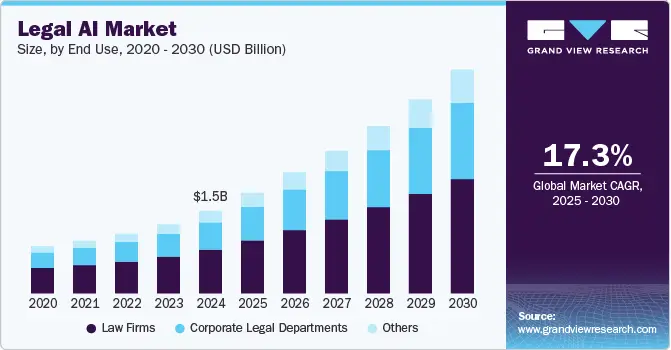
The AI-Powered Legal Department
How AI Will Reshape Legal Workflows
The days of legal departments drowning in paperwork and manual processes are rapidly fading. By 2030, AI-driven technologies will form the backbone of legal operations, fundamentally transforming how legal work gets done.
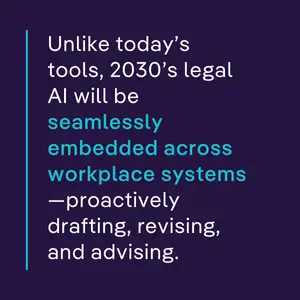
Contract review—traditionally one of the most time-consuming responsibilities for legal teams—will be handled primarily through AI systems capable of analyzing documents with superhuman speed and accuracy. According to the 2023 Thomson Reuters Legal Department Operations Index, 70% of legal departments report higher matter volumes while 66% face flat or declining budgets, making AI automation a crucial strategy for managing increased workloads.
Corporate legal departments will continue their evolution from reactive problem-solvers to proactive strategic partners. This transformation will be enabled by AI that continuously monitors business operations, identifying potential legal risks before they materialize and offering strategic guidance to mitigate them.
Perhaps the most significant change will be the integration of LLM-powered legal assistants into daily workflows. Unlike today’s emerging tools that require specific prompting and oversight, 2030’s legal AI assistants will be seamlessly embedded into all workplace systems—drafting responses to regulatory inquiries, generating contract modifications based on negotiation history, and providing real-time compliance guidance during business meetings.
Predictive Analytics and Automation
By 2030, predictive analytics will revolutionize how legal departments assess and manage risk. Using vast datasets from both internal sources and anonymized industry data, AI systems will forecast potential legal challenges with remarkable accuracy. Research from McKinsey’s State of AI report indicates that organizations using advanced AI and predictive analytics are seeing significant risk reduction benefits across multiple business functions.
These predictive systems will:
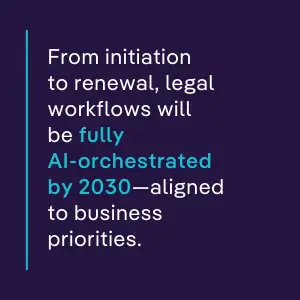
- Identify contractual arrangements most likely to result in disputes
- Flag early warning signs of potential compliance violations
- Predict litigation outcomes with greater accuracy than human experts, building on the Harvard research on legal AI systems demonstrates how AI is assisting lawyers with tasks ranging from legal research to case analysis, with promising accuracy improvements in predictive capabilities.
- Recommend optimal settlement strategies based on comprehensive case analysis
Contract analytics powered by machine learning will deliver insights beyond what human analysis could feasibly uncover. These systems will identify subtle patterns across thousands of agreements, enabling legal departments to make data-driven decisions about everything from negotiation strategies to vendor management.
Automation will extend far beyond simple document assembly. By 2030, entire legal workflows—from contract initiation to approval, storage, obligation management, and renewal—will be orchestrated by AI systems that understand organizational priorities and adapt processes accordingly.
AI-Augmented Legal Decision-Making
AI will dramatically transform how legal disputes are resolved. Advanced prediction engines will analyze millions of historical cases, party backgrounds, judicial tendencies, and jurisdictional patterns to produce remarkably accurate outcome predictions.
Contract negotiation will likewise be revolutionized. AI systems will analyze counterparty history, industry standards, and organizational preferences to suggest optimal negotiation strategies and acceptable fallback positions. These systems will enable even junior legal professionals to negotiate with the collective wisdom of the entire legal department behind them.
For routine contracts, AI will enable true “touchless” processing—contracts that meet pre-established criteria will flow through approval workflows without human intervention, dramatically accelerating business velocity while maintaining appropriate risk controls.
Evolving Legal Roles in 2030
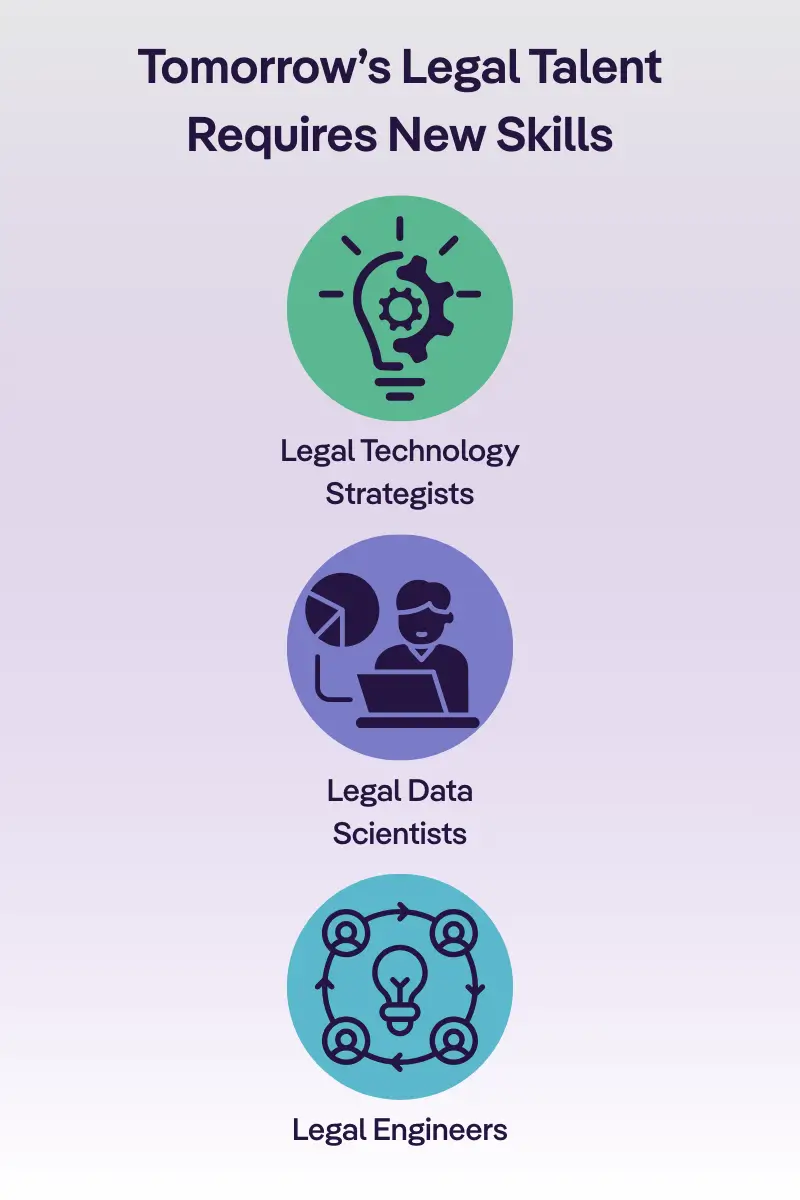
New Skills Required for Legal Professionals
The legal profession of 2030 will demand a fundamentally different skill set than today’s practice. While deep legal knowledge will remain valuable, it alone will be insufficient. Tomorrow’s legal professionals will need to develop expertise across multiple domains:
Legal Technology Strategists will design AI implementation roadmaps that align technological capabilities with business objectives. These professionals will understand both legal processes and AI capabilities deeply enough to envision transformative applications.
Legal Data Scientists will emerge as critical team members, responsible for ensuring AI systems are trained on appropriate data, monitoring for bias, and continuously improving system performance through refined models and better training methods.
Legal Engineers will bridge the gap between technical teams and legal experts, translating legal requirements into technical specifications and ensuring AI systems properly reflect legal reasoning.
Even traditional roles will require new skills. Contract attorneys will need to understand how to effectively oversee and validate AI-driven contract analysis. Litigators will require proficiency in working with prediction engines and data visualization tools to build compelling cases.
The End of Manual Legal Work?
While AI will dramatically reduce manual work, human legal professionals will remain indispensable—albeit in evolved roles.
Tasks that will be largely automated by 2030 include:
- Routine document review and contract analysis
- Basic legal research and case law identification
- Standard contract generation and modification
- Compliance monitoring and routine reporting
- Initial case assessment and outcome prediction
However, critical aspects of legal work will remain predominantly human-led:
- Novel legal strategy development
- High-stakes negotiation and relationship management
- Complex regulatory interpretation
- Crisis management and reputational risk mitigation
- Ethical decision-making in ambiguous situations
The value of legal professionals will increasingly derive from uniquely human capabilities—creativity, emotional intelligence, ethical judgment, and strategic thinking—rather than technical legal knowledge alone.
The Shift to Proactive Legal Strategy
Perhaps the most profound transformation will be the shift from reactive to proactive legal management. Today’s legal departments primarily respond to issues after they arise; tomorrow’s legal teams will prevent problems before they materialize.
AI-powered monitoring systems will continuously analyze business operations, communications, and market conditions to identify emerging legal risks. These systems will alert legal teams to potential issues—from contract compliance failures to harassment risks—enabling intervention before situations escalate.
Compliance monitoring will evolve from periodic audits to continuous, real-time oversight. AI systems will automatically detect potential violations, investigate root causes, and even implement remedial measures for routine issues.
Proactive approaches like this have the potential to dramatically reduce litigation, regulatory penalties, and reputational damage—transforming legal departments from cost centers managing problems into value centers preventing them.
The Business Model Transformation
From Billable Hours to Value-Based Legal Services
According to Thomson Reuters’ research in Australia, “43 per cent of new fees and matters in Australian law firms being charged on a fixed fee basis,” showing significant movement toward alternative billing models. Corporate legal departments will increasingly adopt subscription-based models for both internal operations and external counsel relationships. Recent Thomson Reuters analysis reveals that “76% of teams ranking outside counsel cost control as a top priority” with many legal departments increasingly turning to alternative fee structures. These arrangements will provide businesses with predictable legal costs while incentivizing efficiency and prevention rather than prolonged problem management.
AI-driven self-service legal tools will handle routine matters without direct lawyer involvement. Employees throughout organizations will use conversational AI interfaces to generate NDAs, basic employment agreements, and other standard documents—with appropriate guardrails and escalation paths for complex situations.
Legal Tech Partnerships and Ecosystems
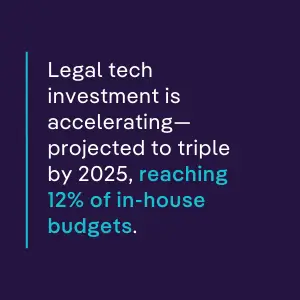
By 2030, integrated legal tech platforms will replace today’s fragmented point solutions. These comprehensive platforms will manage the entire contract lifecycle, litigation portfolio, IP assets, and compliance obligations through a unified interface powered by sophisticated AI. The transformation is already underway, with Gartner reporting a prediction that “legal technology spending will increase to approximately 12% of in-house budgets by 2025, a threefold increase from 2020 levels.”
Corporate legal departments, legal tech providers, and traditional law firms will form complex ecosystems, sharing anonymized data to improve collective intelligence while maintaining appropriate confidentiality. These collaborative arrangements will accelerate innovation while distributing development costs across multiple stakeholders.
ContractPodAi’s platform strategy exemplifies this approach, creating an ecosystem where corporate legal teams can seamlessly integrate best-in-class tools while maintaining a consistent user experience and centralized data repository.
Ethical, Regulatory, and Data Challenges
AI Governance and Compliance
As legal departments increasingly rely on AI for critical functions, robust governance frameworks will become essential. By 2030, most large corporate legal departments will have established AI ethics committees responsible for overseeing algorithmic decision-making and ensuring appropriate human oversight. Analysis from the Economics Observatory shows how governance frameworks for AI in legal departments have become essential as the adoption of these technologies accelerates.
Key governance challenges will include:
- Establishing clear accountability for AI-generated legal work
- Ensuring appropriate transparency in AI decision-making processes
- Implementing effective human oversight of automated systems
- Managing potential algorithmic bias in legal predictions and recommendations
Legal departments that fail to implement strong AI governance frameworks will face significant risks, including potential regulatory penalties, litigation concerning AI decisions, and reputational damage from algorithmic failures.
Privacy and Data Protection in 2030
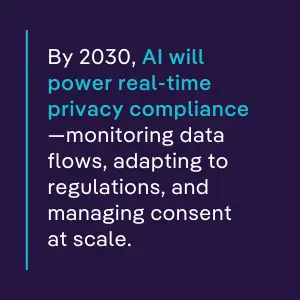
By 2030, privacy regulations will have expanded significantly beyond today’s frameworks. AI systems will play a dual role—creating compliance challenges while simultaneously enabling more effective privacy management.
Some legal departments will deploy AI systems that continuously monitor data flows, automatically identifying potential privacy violations and implementing remedial measures. These systems will adapt in real-time to regulatory changes across jurisdictions, ensuring consistent compliance in an increasingly complex global privacy landscape.
AI-powered privacy tools will enable granular data management at scale—something impossible with manual processes. These systems will track individual consent preferences, data lineage, and usage rights across billions of data points, enabling both compliance and responsible data utilization.
Mitigating AI Risks in Legal Tech
As legal functions increasingly rely on AI, managing associated risks will become a core responsibility. Legal departments must ensure AI systems provide explainable results, particularly for high-stakes decisions that might later require justification in litigation or regulatory inquiries.
ContractPodAi’s approach to trustworthy AI emphasizes several critical principles:
- Maintaining human oversight of critical decisions
- Ensuring algorithmic transparency and explainability
- Implementing rigorous testing for bias and accuracy
- Providing clear audit trails for AI-influenced decisions
- Regular re-validation of AI systems against evolving standards
By adhering to these principles, legal departments can harness AI’s benefits while mitigating associated risks—striking the optimal balance between innovation and prudence.
Preparing for the AI-Powered Legal Future
The transformation of legal departments won’t happen overnight, but the groundwork must be laid today. Organizations that wait until 2029 to begin their AI transformation will find themselves at a devastating competitive disadvantage.
“Legal departments embracing AI tools today – and understanding the way they work – will create a significant competitive edge for those teams by 2030. Leading teams are already building practical technical and AI competency via real-world applications, while simultaneously developing governance frameworks that will scale with increasingly sophisticated technology. Those who wait for ‘perfect’ AI solutions will find themselves years behind their competitors.”
Jerry Levine, Chief Evangelist & Co-General Counsel, ContractPodAi
Forward-thinking legal leaders should:
- Audit current processes to identify high-impact opportunities for AI implementation
- Develop data strategies that ensure AI systems have access to high-quality, structured information
- Invest in staff training to build the hybrid legal-technical skills that will be essential in 2030
- Establish governance frameworks that enable responsible AI adoption
- Partner with innovative legal tech providers with clear roadmaps for AI development
In Summary
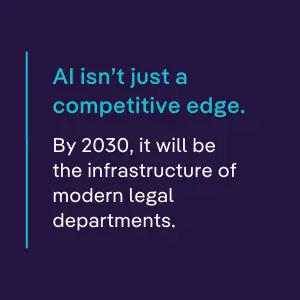
By 2030, AI won’t just be a tool for legal departments—it will be the foundation upon which modern legal operations are built. From predictive analytics to automated workflows, from self-service legal tools to continuous compliance monitoring, AI will transform every aspect of corporate legal practice.
The most successful legal departments will be those that embrace this transformation deliberately and strategically—not just implementing technology, but fundamentally rethinking how legal services are delivered and how legal professionals create value.
The future of legal is AI-augmented, data-driven, and proactive. The time to prepare for this future is now.
Ready to start your legal department’s AI transformation? Explore how Leah, ContractPodAi’s AI-powered legal assistant, can help your team build the foundation for future success today.
AI in Legal Departments: Key FAQs for 2025-2030
How will AI transform legal departments by 2030?
By 2030, AI will form the backbone of legal operations, transforming legal departments from reactive problem-solvers to proactive strategic partners. AI systems will handle contract review with superhuman speed and accuracy, continuously monitor business operations to identify potential legal risks before they materialize, and seamlessly integrate LLM-powered legal assistants into all workplace systems. These assistants will draft responses to regulatory inquiries, generate contract modifications based on negotiation history, and provide real-time compliance guidance during business meetings.
What skills will legal professionals need in an AI-powered legal department?
By 2030, legal professionals will need a blend of legal expertise and technical skills. New roles will include Legal Technology Strategists who design AI implementation roadmaps, Legal Data Scientists who ensure AI systems are properly trained and monitored for bias, and Legal Engineers who bridge the gap between technical teams and legal experts. Even traditional roles will require technological proficiency—contract attorneys will need to effectively oversee AI-driven contract analysis, while litigators will need to work with prediction engines and data visualization tools.
What is the projected growth of the legal AI market between 2025 and 2030?
According to Grand View Research, the legal AI market is expected to grow from approximately $1.75 billion in 2025 to about $3.90 billion by 2030, representing a compound annual growth rate (CAGR) of 17.3%. This significant growth reflects the increasing adoption of AI technologies by legal departments facing higher matter volumes with flat or declining budgets, making AI automation crucial for managing increased workloads efficiently.
How can legal departments prepare today for an AI-powered future?
Forward-thinking legal departments should prepare for an AI-powered future by auditing current processes to identify high-impact opportunities for AI implementation, developing data strategies to ensure AI systems have access to high-quality structured information, investing in staff training to build hybrid legal-technical skills, establishing governance frameworks for responsible AI adoption, and partnering with innovative legal tech providers who have clear roadmaps for AI development. Organizations that delay their AI transformation until the late 2020s will find themselves at a significant competitive disadvantage.


